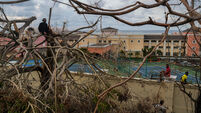Disaster expert faces big test after hurricane
Michael Brown, the head of the United States Federal Emergency Management Agency, was hand-picked by the President to take charge of the recovery effort in the wake of Hurricane Katrina.
It is without doubt the biggest test of his career.
How he handles the evolving crisis is being carefully monitored, not only by the White House, but by international governments, US citizens and countless victims.
The 51-year-old was handed control of FEMA by George Bush in 2003, his role to co-ordinate disaster response and recovery operations with some 25 agencies and the American Red Cross.
Since taking the post he has largely avoided criticism.
He has led the US government’s response to more than 164 disasters and emergencies, including the 2003 Columbia shuttle disaster and California wildfires.
Last year he led FEMA’s thousands of dedicated disaster workers in Florida during the most active hurricane season in over 100 years.
FEMA was credited with delivering aid more quickly and more efficiently than ever before.
But this time is different. Mr Brown has been widely criticised for deploying too little help too late.
Even President Bush today declared that the response effort was unacceptable.
A trained lawyer, Mr Brown was born in Oklahoma and is married with two children and one grandchild.
He has worked in city and state government but had relatively little experience is emergency response training before taking control of the federal agency.
Shortly after the September 11 terrorist attacks he worked on the White House’s policy co-ordination group for the domestic response to the attacks.
Later he headed the Consequence Management Working Group to identify and resolve key issues regarding the federal response plan.
He took over from his close friend, Joe Allbaugh, as FEMA director in January 2003. Two years earlier it became part of the Department of Homeland Security, a move many feared would mean less attention for disaster relief.
Unlike Florida, New Orleans had dodged a direct hit from a major hurricane for four decades.
But because the city sits in a bowl below sea level, FEMA predicted in 2001 that it was one of the top three likeliest, most catastrophic disasters facing America.
Mr Allbaugh, then-FEMA director, told a conference: “It is our job at FEMA to think the unthinkable in terms of disasters, and to prepare for those that will become catastrophic.”
“I want our most vulnerable communities to plan for the worst. A Category 5 hurricane in an urban area would stretch our current response and recovery capabilities to the breaking point.”
But little was done to prevent potential flood levee breaches which have now pracically obliterated the city.
Mr Brown has blamed a lack of communication for the dire situation in the city. Other officials have suggested it was the design of the levees rather than an alleged cut in funding.
Mr Brown has refused to be drawn into a political debate about whether the White House should be faulted. “I’m focused on lifesaving efforts,” he said.













